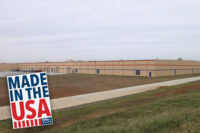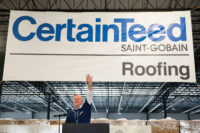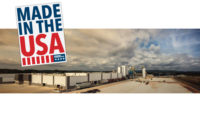Recent capital investments by Carlisle Construction Materials include a new insulation plant in Washington, a new polyiso plant in New York, a new TPO line in Pennsylvania and a new PVC line in Illinois.
According to the people at Carlisle, these investments are just the latest examples in a history of innovation that spans more than 50 years. They also demonstrate the company’s commitment to providing an outstanding array of top-quality roofing products to help contractors meet and exceed the demands of building owners across the country.
Carlisle’s new PVC manufacturing line was installed in December of 2013 in Greenville, Ill. In April of 2014, the company held a ribbon-cutting ceremony to celebrate the achievement. As part of Roofing Contractor’s Made in the USA series, Joe Stassi, director of PVC sales and marketing, and John Greko, PVC product manager, shared their insights about the capabilities of the new PVC line, the business philosophy behind the decision to enter the PVC market and the ways the company strives to meet the needs of its customers.
State of the Art
According to Stassi, the PVC line represents an investment of more than $35 million. It can produce a variety of membranes, including polyester- and fiberglass-reinforced PVC, as well as fleece-backed membranes, in a single pass. The line also produces the company’s KEE HP PVC, which won the Best New Product award at the 2014 International Roofing Expo (IRE).
The line was added to the company’s Greenville facility, which was an ideal location. “In terms of the planning, it was very centrally located for the PVC market, so it’s ideally situated for freight to the East Coast, the West Coast, north and south,” Stassi said.
The line reflects cutting-edge manufacturing equipment. “The technology that went into that line is state of the art — and not by a little bit,” Stassi said. “It is far and away the most advanced line in the marketplace today. We’re very proud of how quickly the folks at the plant were able to bring it online, and everything has been going exceptionally well with that facility to date.”
According to Greko, the facility is designed to handle every phase of manufacturing process, from the raw components to the packaged product. High-tech controls and a new blending tower make it all possible.
“What’s nice about the controls is that they increase the quality of the product,” Greko said. “This line is designed with load cells on every drive roller, which maintains and monitors by computer system the tension put on the material all the way through. So just by the design of the machine and by the process, the finished product coming off the line is better than it would be on other types of not-as-advanced lines.”
The blending tower was designed to combine the raw materials for all of the company’s products and allow for future additions. “The blending tower was designed to produce everything we produce now and anything that we may think of in the future,” Greko said. “If we decide to expand and add new products, we have the capability to make those as well.”
Greko noted that the line was also designed to minimize the impact on the environment. “We’re monitoring 10,000 data points constantly across the line so that we can increase efficiency, reduce energy consumption and at the same time minimize waste,” he said. “It also decreases startup time and shutdown time, which are both waste factors in a production line.”
Any trim or unused PVC is either recycled for use on the bottom ply of PVC or used in vinyl flooring.
A Broad Range of Offerings
According to Stassi, entering the PVC market was a natural progression for the company. “Our contractors asked us to do this,” Stassi noted. “There were a lot of folks out there that just said, ‘You guys need to get into the PVC business.’ And we’ve had a lot of success right out of the gate, not only with the contractor community wanting to buy the material from us, but also our relationships at the owner, specification and consultant and architectural end, where folks have confidence in us and our ability to get the right system to them for the right geography when it comes to thermoplastic membranes.”
A broad offering of products and systems is an integral part of the company’s strategy, noted Stassi. “It’s a huge plus for us,” he said. “With a portfolio including PVC, EPDM and TPO, we can approach the market with more of an unbiased approach. We’re not selling one membrane. I think the roofing community depends on us to look at it from an unbiased standpoint to determine what the best roof is for any particular situation.”
Greko stressed the number of options available in the PVC line alone. “Our product offering is probably the broadest product offering of any PVC manufacturer out there, so the customer can make decisions and not be narrowed in the choices,” Greko said. “We offer different colors. We offer different sizes. We have lines of bare-back membranes and fleece-back membranes, and we do that both in the PVC line and the KEE line. A broad range of accessories makes the contractor’s application a lot easier.”
Tapping Into the Contractor Community
Stassi and Greko emphasized Carlisle’s effort to keep the lines of communication open with contractors through a variety of methods, including trade publications, trade shows like the IRE, the company’s sales reps and its distributor partners. Carlisle also hosts a contractor council several times a year. The company provides educational sessions and gathers feedback. “We listen to the voice of the customer,” Stassi said. “They have a lot of impact on the direction we are going. We like to hear from the folks who are utilizing our products.”
Stassi noted that contractor feedback led to changes in packaging, for example, including reducing the number of rolls per pallet.
Contractors also suggested several additions to the accessory lines for PVC, TPO and EPDM products. “Our accessory line is what it is today based on feedback from the contractor community,” Stassi said. “Our basic premise is if the contractor can draw it, we’ll make it for him.”
The company’s overriding goal is to help contractors provide the perfect roof for any situation, according to Stassi. “We can help them develop the system that meets the needs of their customers,” he said. “From an energy standpoint, we can show them why it works and how the system works together, depending on the insulation, the color of the membrane and the application at their particular facility.”
Everything works best when ideas flow both ways, noted Greko. “Contractors are our ultimate customer,” he said. “We have to learn from them and reach out to them as much as we can to learn what we need to do.”








Report Abusive Comment